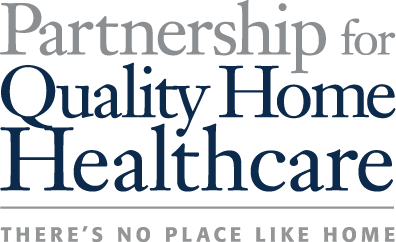As our nation confronts the COVID-19 outbreak, the home health community is working aggressively to protect patients, home health care providers, and the communities we serve. Coordinating with the government, as well as other healthcare providers, Partnership members are supporting a unified front in efforts to treat patients and contain the virus. Following guidelines from the Centers for Disease Control and Prevention, the home health community has been screening patients and the home health professionals who care for them to mitigate risk of exposure.
As an industry of highly skilled professionals caring for vulnerable populations with multiple chronic conditions, home healthcare agencies are uniquely qualified to treat individuals diagnosed with COVID-19. With more Americans becoming vulnerable to contracting COVID-19, home health represents a safe and available care setting for at-risk populations.
Recognizing that home health can play a major role, The Partnership released a set of recommendations regarding needed waivers and regulatory relief to expand access to home health, ensure patient safety, and streamline and eliminate any barriers to fully engaging the nation’s home health provider community.
As the outbreak continues to develop, the Partnership is working with the Administration and Congress to identify actionable measures for expanding home health under current federal regulations and suggesting specific policy changes to address these issues.
The Partnership is asking for regulatory and legislative relief and clarification in the following areas:
COVID-19 Vaccine Access Prioritization
On November 30, the Partnership joined a coalition of the nation’s leading home care and hospice organizations in sending a letter to the CDC’s Advisory Committee on Immunization Practices (ACIP) expressing support for pending recommendations on the prioritization of vaccine access, which properly includes home care and hospice in ACIP’s definition of the health care workforce. The groups stressed that home care and hospice staff of all disciplines should be included in the first group (Phase 1a) of frontline care workers granted access to the COVID-19 vaccine.
To view the coalition press release, click here.
To view the coalition letter to the CDC ACIP, click here.
Access to the Provider Relief Funds
The financial impact from COVID-19 has significantly reduced home health agency revenue and impacted agency functional and operations. The CARES Act emergency funds and the suspension of the 2% sequestration took steps to address these losses, but more assistance is needed for significant segments of the home health community. PQHH supports the continuation of funding to home health through increased allocations to the Provider Relief Funds during the crisis period to stabilize home health agencies. This will prevent widespread agency fiscal instability, staff layoffs, and maintain access to care throughout the pandemic. Funds will also help to mitigate the increased costs to agencies due to COVID-19.
Flexibility on Physician Signature Requirements
During this public health emergency, many physician offices are closed and the routine communication system between physicians and home health providers is broken. CMS must afford reasonable flexibility during this time and allow verbal orders to be sufficient for agencies to be able to bill for services.
Telephonic & Telehealth Visits
Home health nurses and clinicians need to be deployed and have flexible use of technology, like telephones and telehealth units, to monitor existing patients who want to limit anyone (including clinicians) from visiting their home and for COVID-19 patients needing health care monitoring by trained clinicians. Examples of tele-monitoring include monitoring blood pressure and other vitals, oxygen levels, weight, temperature, medication management and patient education. CMS should immediately consider telephonic visits a part of the care plan, as well as allow greater flexibility in the use of telehealth visits in a patient’s plan of care.
Personal Protective Equipment
PPE supplies are running low but are critical to preventing exposure during home health visits of COVID-19 positive or quarantined patients that could harm home health workers or spread the virus to other homebound patients. Home health agencies are looking to CMS and the CDC for guidance on how to maximize the use of PPE, ensure that PPE stockpile availability includes home health providers, and are also pressing for federal agencies to consider supply chain interventions in order to ensure continued access to PPE.
Media Inquiries
If you would like to speak to a Partnership representative or member of the home health community about the sector's response to the COVID-19 crisis, please contact Ellen Almond at ealmond@schmidtpa.com.
